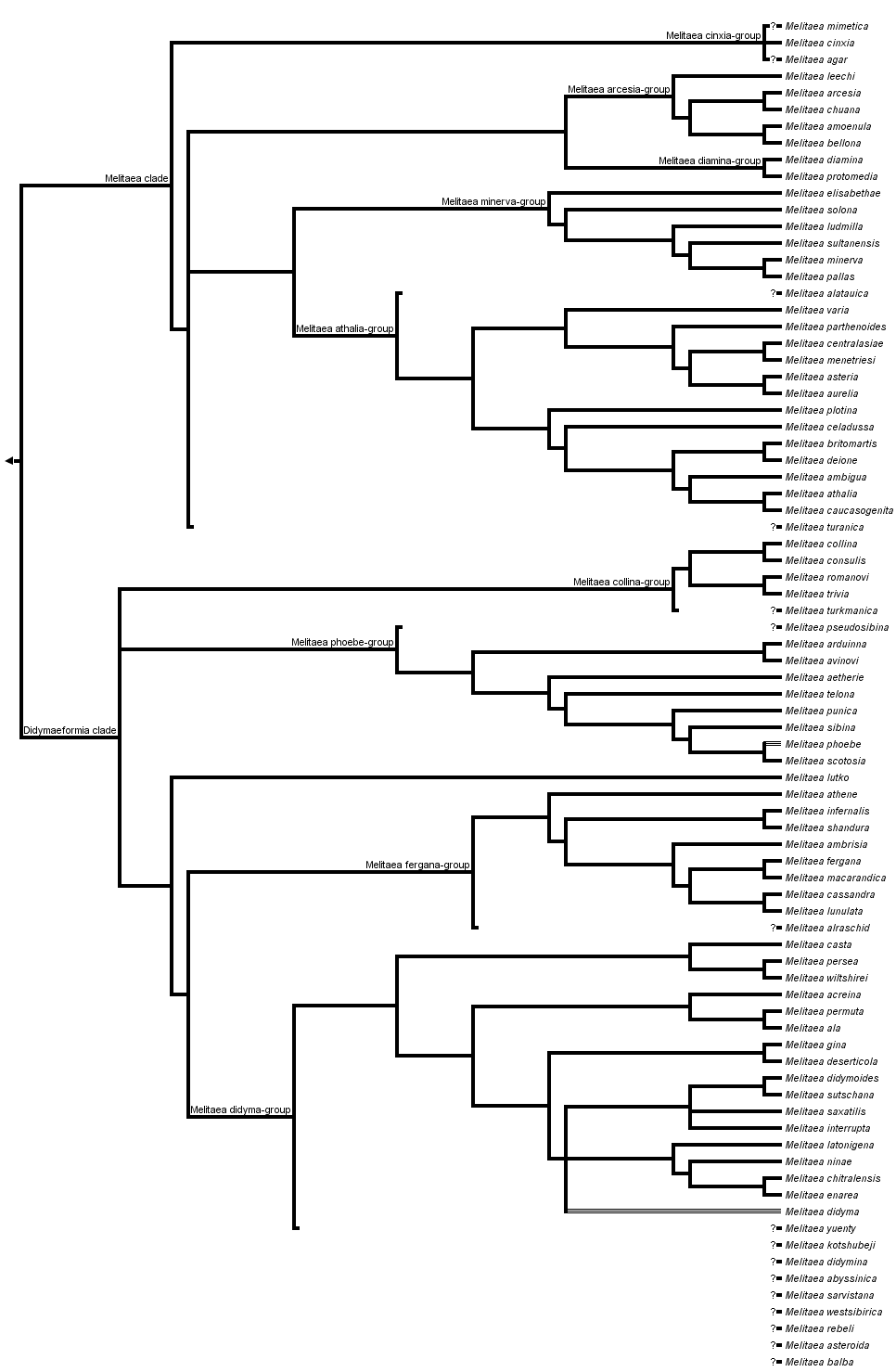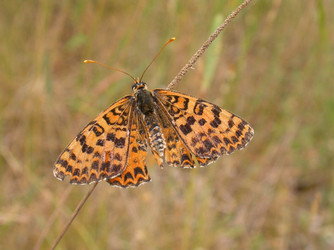Melitaea
"Fritillaries"
Niklas Wahlberg and Andrew V. Z. Brower


This tree diagram shows the relationships between several groups of organisms.
The root of the current tree connects the organisms featured in this tree to their containing group and the rest of the Tree of Life. The basal branching point in the tree represents the ancestor of the other groups in the tree. This ancestor diversified over time into several descendent subgroups, which are represented as internal nodes and terminal taxa to the right.

You can click on the root to travel down the Tree of Life all the way to the root of all Life, and you can click on the names of descendent subgroups to travel up the Tree of Life all the way to individual species.
For more information on ToL tree formatting, please see Interpreting the Tree or Classification. To learn more about phylogenetic trees, please visit our Phylogenetic Biology pages.
close boxDiscussion of Phylogenetic Relationships
Phylogenetic relationships as inferred from DNA sequences by Leneveu et al. (2009). The topology is based on the strict consensus of results from parsimony analysis (their Fig. 2A). Note that in the original figure, different individuals of Melitaea didyma appear in four different places on the tree: as sister to M. ninae, sister to (M. ninae + M. didyma + M. chitralensis + M. enarea), sister to M. latonigi, and in the polytomy with M. saxatilis, etc. The position indicated here is the Adams compromise (most basal node including all representatives). The polyphyly of the "species" suggests that M. didyma may be a complex of similar-looking species (or that all the other "species" in the clade are variable populations of M. didyma.
Taxa not included in the Leneveu et al. study are indicated as incertae sedis associated with their putative species groups.
Other Names for Melitaea
- Lucina
- Cinclidia
- Schoenis
- Mellicta
- Melinaea
- Athaliaeformia
- Didymaeformis
- Vernacular Names: "Fritillaries"
References
Leneveu, J., Chichvarkhin, A. & Wahlberg, N. 2009 Varying rates of diversification in the genus Melitaea (Lepidoptera: Nymphalidae) during the past 20 million years. Biol. J. Linn. Soc. 97:346-361.
Wahlberg, N., A. V. Z. Brower, and S. Nylin. 2005. Phylogenetic relationships and historical biogeography of tribes and genera in the subfamily Nymphalinae (Lepidoptera: Nymphalidae). Biological Journal of the Linnean Society 86:227-251.
Wahlberg, N., and M. Zimmermann. 2000. Pattern of phylogenetic relationships among members of the tribe Melitaeini (Lepidoptera: Nymphalidae) inferred from mtDNA sequences. Cladistics 16:347-363.
Title Illustrations

| Scientific Name | Melitaea varia |
|---|---|
| Specimen Condition | Live Specimen |
| Source | Mellicta varia |
| Source Collection | Flickr |
| Image Use |
 This media file is licensed under the Creative Commons Attribution-NonCommercial-ShareAlike License - Version 2.0. This media file is licensed under the Creative Commons Attribution-NonCommercial-ShareAlike License - Version 2.0.
|
| Copyright | © 2008 YannickC |
| Scientific Name | Melitaea didyma |
|---|---|
| Location | France, Aude, Villegly |
| Specimen Condition | Live Specimen |
| Identified By | Niklas Wahlberg |
| Sex | Female |
| Image Use |
 This media file is licensed under the Creative Commons Attribution-NonCommercial License - Version 3.0. This media file is licensed under the Creative Commons Attribution-NonCommercial License - Version 3.0.
|
| Copyright |
© Niklas Wahlberg

|
About This Page
Niklas Wahlberg

University of Turku, Finland

Middle Tennessee State University, Murfreesboro, Tennessee, USA
Correspondence regarding this page should be directed to Niklas Wahlberg at and Andrew V. Z. Brower at
Page copyright © 2009 Niklas Wahlberg and
 Page: Tree of Life
Melitaea . "Fritillaries".
Authored by
Niklas Wahlberg and Andrew V. Z. Brower.
The TEXT of this page is licensed under the
Creative Commons Attribution License - Version 3.0. Note that images and other media
featured on this page are each governed by their own license, and they may or may not be available
for reuse. Click on an image or a media link to access the media data window, which provides the
relevant licensing information. For the general terms and conditions of ToL material reuse and
redistribution, please see the Tree of Life Copyright
Policies.
Page: Tree of Life
Melitaea . "Fritillaries".
Authored by
Niklas Wahlberg and Andrew V. Z. Brower.
The TEXT of this page is licensed under the
Creative Commons Attribution License - Version 3.0. Note that images and other media
featured on this page are each governed by their own license, and they may or may not be available
for reuse. Click on an image or a media link to access the media data window, which provides the
relevant licensing information. For the general terms and conditions of ToL material reuse and
redistribution, please see the Tree of Life Copyright
Policies.
- First online 25 September 2006
- Content changed 04 June 2009
Citing this page:
Wahlberg, Niklas and Andrew V. Z. Brower. 2009. Melitaea . "Fritillaries". Version 04 June 2009 (under construction). http://tolweb.org/Melitaea/70305/2009.06.04 in The Tree of Life Web Project, http://tolweb.org/









 Go to quick links
Go to quick search
Go to navigation for this section of the ToL site
Go to detailed links for the ToL site
Go to quick links
Go to quick search
Go to navigation for this section of the ToL site
Go to detailed links for the ToL site